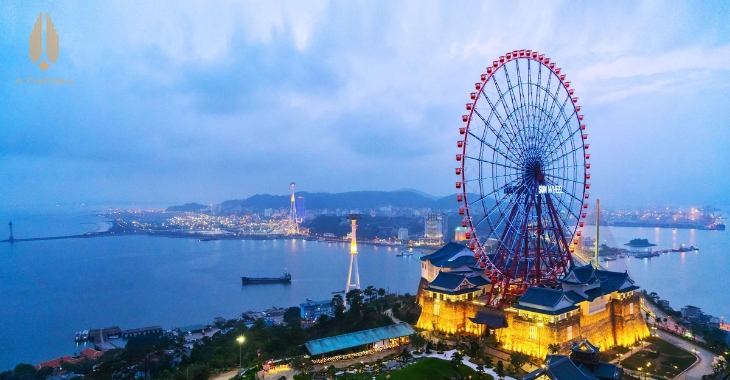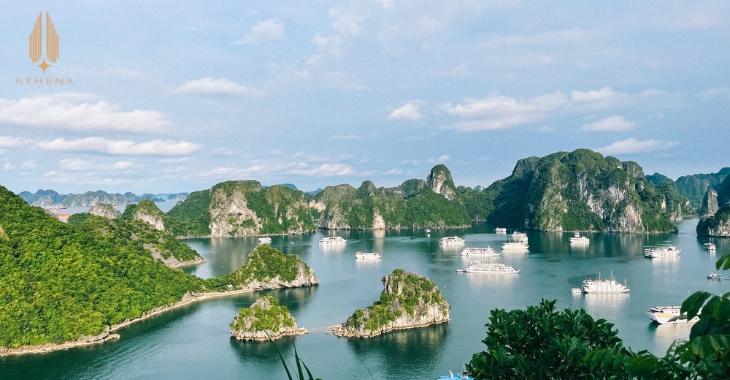Ha Long Bay self-guided tour: The a-z complete guide for a perfect trip
Going beyond conventional itineraries, independent travel allows for a deeper connection with the landscapes, local culture, and hidden gems of this iconic destination. Drawing from real-world experiences, this comprehensive A-to-Z guide is designed to be your essential companion for planning an unforgettable self-guided trip to Ha Long Bay.
1. Pre-trip planning for your Ha Long Bay self-guided tour
Ha Long Bay, a UNESCO-recognized natural wonder, continues to captivate those with a passion for discovery. As travelers seek greater freedom and authenticity in their journeys, self-guided tours of Ha Long Bay are rising in popularity - offering a personalized way to experience the region's breathtaking beauty.
To ensure a fulfilling and memorable self-guided tour of Ha Long Bay, thorough pre-trip planning is paramount. Here are the crucial aspects that require careful consideration:


1.1. Choosing the ideal time to visit
Selecting the right time to explore Ha Long Bay plays a crucial role in shaping the overall travel experience. Long-term climate observations highlight autumn (September – November) and spring (March – April) as the most favorable periods, featuring mild weather, clear skies, and minimal rainfall - ideal conditions for sightseeing and maritime excursions. Summer (April – September) brings a lively atmosphere but is prone to tropical showers and storms. Winter (December – February) tends to be cold and foggy, potentially impacting visibility and cruise comfort.
1.2. Planning a Detailed Itinerary
A flexible yet well-structured itinerary will help you maximize your time during a Ha Long Bay self-guided tour.
- A suggested 2-day, 1-night itinerary focuses on highlights such as the central bay sightseeing route (Thien Cung Cave, Dau Go Cave, Fighting Cock Island) and Bai Chay Beach or Tuan Chau Island.
- A 3-day, 2-night itinerary can extend exploration to the outer bay (Sung Sot Cave, Ti Top Island, Luon Cave), include kayaking, and visits to fishing villages.
Travelers have the flexibility to fully customize their itinerary based on their preferences and available time.
1.3. Transportation to Ha Long Bay
Selecting the right mode of transport is the crucial first step in your self-guided Ha Long Bay adventure.
- Buses are a popular and economical option with numerous reputable companies operating routes from Hanoi - Ha Long and Hai Phong - Ha Long.
- Trains are also a viable option, although travel time is longer.
- For those traveling from afar, Van Don International Airport (Quang Ninh) serves as the closest air gateway, from which Ha Long City can be reached by bus or taxi.
Renting a self-drive car offers significant flexibility but requires consideration of road conditions and parking availability.
1.4. Accommodation in Ha Long Bay
Ha Long Bay offers a wide selection of accommodations tailored to the diverse preferences and budgets of self-guided travelers. Depending on your travel style, location matters when choosing where to stay:
- Bai Chay: This is the main tourist center, offering a dense concentration of hotels ranging from budget to luxury. It’s ideal for those who want convenient access to major attractions and vibrant nightlife.
- Hon Gai: Located across the Bai Chay Bridge, Hon Gai provides a quieter, more local atmosphere. It features boutique hotels and homestays, making it suitable for travelers who prefer a more authentic and peaceful experience.
- Tuan Chau island: Known for its upscale resorts and proximity to cruise ports, this area is perfect for those seeking comfort, exclusivity, and direct access to overnight cruises.
Booking accommodation in advance, particularly during peak travel seasons (summer, weekends, holidays), is strongly recommended to secure the best rates and availability.
1.5. Dining in Ha Long Bay
Exploring Ha Long Bay’s culinary scene is a must for any self-guided traveler. The region’s coastal location offers a bounty of fresh seafood, with many dishes that are both unique and deeply rooted in local tradition.
Popular local specialties include:
- Grilled squid (Cha Muc) – a famous Ha Long delicacy, known for its chewy texture and rich flavor.
- Peanut worms (Sa Sung or Ngan) – a rare and high-value ingredient typically stir-fried or served with rice wine.
- Horseshoe crab (Sam Bien) – often prepared as salad or fried eggs, found in coastal restaurants.
- Geoduck clam (Tu Hai) – a sweet, meaty shellfish best when grilled or steamed.
Recommended places to eat:
- Seafood restaurants in Bai Chay: ideal for variety and convenience.
- Local eateries in Hon Gai: great for authentic and affordable meals.
- Floating restaurants on the bay: offer fresh seafood and a unique dining atmosphere on water.
Tip: Always check online reviews and ask about prices beforehand to avoid overpaying and to ensure a satisfying culinary experience.
See more: Halong Bay what to eat what to do where to stay?
See more: Halong Bay what to eat what to do where to stay?
1.6. Budgeting for your trip
Effective budget planning is essential for a smooth, worry-free self-guided tour of Ha Long Bay. While the trip can be customized based on spending preferences, travelers should account for the following key expenses:


- Transportation: includes buses, trains, taxis, or car rentals to and around Ha Long.
- Accommodation: varies by area and hotel class.
- Dining: daily meals at restaurants, cafes, or local food stalls.
- Entrance fees: required for bay access, caves, islands, and certain attractions.
- Boat or kayak rentals: for exploring the bay independently or via guided day tours.
- Recreational activities: such as cruises, cultural tours, or water sports.
- Contingency funds: to cover unexpected situations like medical issues, itinerary changes, or transportation delays.
Pro tip: Create a detailed budget in advance, research local pricing, and carry some cash in case card payments are not accepted in certain areas.
1.7. Essential items to pack
To ensure a smooth and comfortable self-guided tour of Ha Long Bay, travelers should prepare a well-thought-out packing list. Being adequately equipped helps prevent unnecessary inconveniences and enhances the overall travel experience.
Key items to bring include:
- Clothing suitable for the weather: Lightweight, breathable clothes for summer; warm layers for winter; and a waterproof jacket in case of rain.
- Swimwear: Essential if planning to swim, kayak, or participate in beach activities.
- Sun protection: Sunscreen with high SPF, sunglasses, and a wide-brimmed hat to shield against intense sun exposure.
- Insect repellent: Especially important when visiting caves, forests, or coastal areas during the warmer months.
- Personal medications: Any essential prescription drugs, motion sickness pills (for boat travel), and a basic first-aid kit.
- Identification documents: Passport, ID card, driver’s license, or any paperwork required for hotel check-in and transport verification.
Optional but useful items include reusable water bottles, waterproof bags for electronics, and travel apps pre-installed on your phone for navigation, bookings, and local recommendations.
Packing smartly not only enhances comfort but also allows for greater flexibility and peace of mind during your Ha Long Bay journey.
2. Exploring Ha Long Bay on your own
Recognized twice as a UNESCO World Natural Heritage site, Ha Long Bay is a must-visit destination for those who seek scenic beauty and cultural depth. A self-guided journey allows travelers the flexibility to explore at their own pace and experience the Bay’s wonders in a personalized and fulfilling way.
2.1. Must-visit attractions
Ha Long Bay stands as the centerpiece of any independent exploration. Spectacular caves such as Thien Cung, Dau Go, and Sung Sot captivate visitors with their intricate stalactite formations. Iconic islands like Fighting Cock, Incense Burner, and Ti Top are signature spots, ideal for sightseeing and photography. A cruise - ranging from a few hours to overnight trips - offers sweeping views of the bay’s limestone karsts and emerald waters. Beyond the Bay, attractions such as Bai Chay Beach, Tuan Chau Island, traditional fishing villages, Bai Tho Mountain, and the Quang Ninh Museum add cultural and recreational depth to the itinerary.


2.2. Engaging activities
Traveling Ha Long Bay independently empowers visitors to tailor activities to their own interests. Kayaking or stand-up paddleboarding through limestone caves reveals hidden corners of the Bay. Climbing Bai Tho Mountain rewards with panoramic views. Relaxing on pristine beaches or opting for a seaplane tour - budget permitting - provides a fresh perspective from above. In the evening, exploring the lively Ha Long Night Market offers a glimpse into local life and cuisine.
2.3. Themed itinerary ideas
For a more curated experience, consider building a themed itinerary. A romantic escape could include a sunset cruise and a private onboard dinner. A family vacation might center around child-friendly destinations such as Tuan Chau and Bai Chay. Nature lovers could seek off-the-beaten-path adventures with hiking and kayaking in less touristy areas, allowing for a deeper connection with the landscape.
3. Useful tips and advice for a self-guided trip to Ha Long Bay
A self-guided tour of Ha Long Bay is not only an exciting journey but also one that benefits greatly from careful preparation. Insights from previous travelers highlight that thoughtful budgeting, choosing the right time to travel, and smart transport choices can lead to substantial savings and enhanced experiences.
Plan budget and book in advance:
- Researching service prices and estimating costs early helps avoid unexpected expenses. During peak seasons, securing cruise tickets, accommodations, and entrance passes in advance is crucial to prevent limited availability or inflated prices.
Choose the right time to visit:
- Ha Long’s weather varies throughout the year. The best periods are typically from March to May and from September to November, offering mild temperatures and low rainfall. Avoiding the stormy season enhances safety and travel comfort.

Use smart transportation options:
- Combining public and private transport is often efficient and cost-effective. Limousine buses from Hanoi to Ha Long are a preferred choice for their comfort and reasonable pricing.
Follow regulations and protect the environment:
- Adherence to safety rules and environmental guidelines is essential while exploring the Bay. Travelers should refrain from littering and avoid using harmful substances that may pollute the water or harm marine life.
Prepare for weather changes and contingencies:
- Packing essentials such as a light raincoat, sunscreen, basic medications, and weather-appropriate clothing ensures readiness for unexpected conditions.
Leverage travel apps and digital tools:
- Platforms like Google Maps, Traveloka, Booking.com, and local weather apps provide reliable assistance for navigating destinations, booking services, and managing itineraries efficiently.
A self-guided tour to Ha Long Bay offers more than breathtaking views—it’s a chance to immerse in nature, culture, and freedom at your own pace. With the right preparation and an open spirit, every moment in Ha Long becomes a treasured memory.
Book your Athena Cruise today to elevate your journey with premium comfort and unforgettable bay views.
Update:
10 Jun 2025